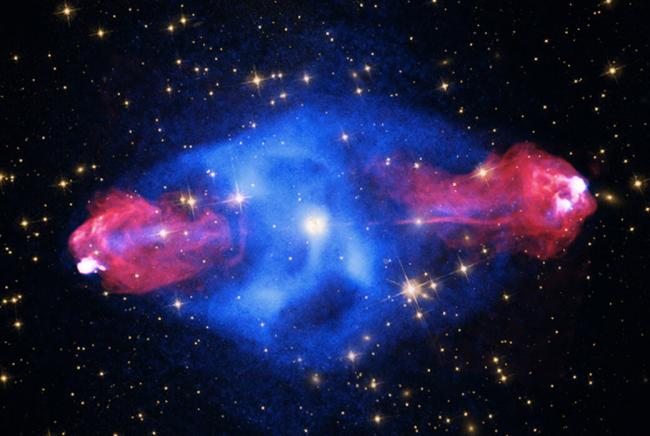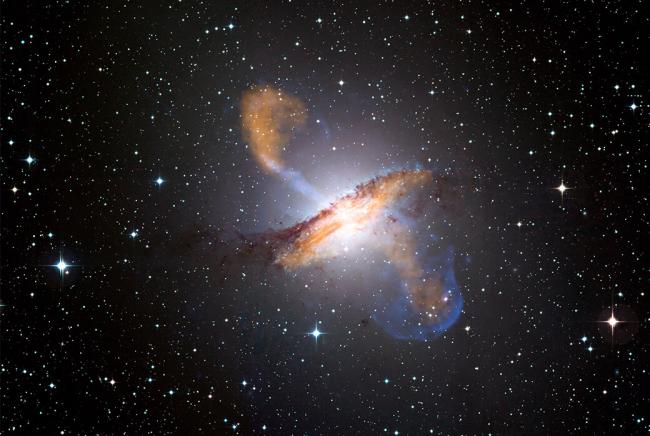Quasars & Other Active Black Holes
Nearly every galaxy harbors at least huge black hole. The powerful gravity from some of those black holes create powerful storms of matter and light, to the point where they outshine their host galaxies and can be seen from billions of light-years away. These black holes include the some of the brightest single objects in the whole universe, and are called “quasars”, “active galactic nuclei”, and other names that describe their appearance to observers.
Our Work
Center for Astrophysics | Harvard & Smithsonian scientists study many aspects of AGNs using a variety of techniques:
-
Using the Event Horizon Telescope (EHT) to study material falling into the supermassive black hole in the galaxy M87. By combining the observing power of telescopes across the globe, EHT captured the first image of matter swirling very close to a black hole, providing new detailed measurements of its behavior.
CfA Plays Central Role In Capturing Landmark Black Hole Image -
Studying gamma rays emitted by AGN jets, including those produced by blazars, the most intense supermassive black holes. While most gamma radiation is blocked by air molecules, the Very Energetic Radiation Imaging Telescope Array System (VERITAS) is a set of four 12-meter telescopes designed to see the cascade of light produced when a high-energy gamma ray enters Earth’s atmosphere.
VERITAS Observes Distant Blazar -
Surveying quasars to map the very distant universe. The Baryon Oscillation Spectroscopic Survey (BOSS) is an ongoing project to map galaxies and active galactic nuclei, to improve our techniques of measuring cosmic distances, as well as to understand the accelerated expansion of the universe.
Astronomers Release the Largest Ever Three-Dimensional Map of the Sky -
Observing AGNs in light from across the entire spectrum, from radio waves to X-rays. These different types of light reveal different aspects of the matter swirling around the black hole, which spans temperatures from close to absolute zero up to millions of degrees.
Outflowing Gas from Galaxy Supermassive Black Hole Nuclei - Using NASA’s Chandra X-ray Observatory and other X-ray telescopes to study the powerful emissions from the innermost regions of quasars and other AGNs. These emissions come from hot matter churning around black holes, along with the intense magnetic fields they produce. The Chandra observatory is able to measure these X-rays to high precision, providing information about the behavior of matter very close to the black hole.
Record-Setting X-ray Jet Discovered
The Engines of Gravity
Astronomers have found supermassive black holes in most galaxies. These weigh in at millions or billions of times the mass of the Sun, but only a few of them are “active” at any one time. To be an active galactic nucleus (AGN), the black hole has to collect a lot of gas around it, where it heats up and glows brightly. In some cases, the black hole also generates huge jets of matter, which stream out at nearly the speed of light. Some jets stretch several times farther than the size of the host galaxy.
What an AGN looks like in our telescopes depends on the angle we’re viewing it. For instance, if the jet is pointing more or less toward Earth, the AGN will appear very bright, even outshining the host galaxy. In those cases, astronomers call the AGN a “quasar” or “blazar”. If the jets aren’t pointing toward Earth or the black hole doesn’t produce jets, the AGN might still be bright, but take on a different look. When the bulk of the galaxy is between us and the black hole, it is only visible in X-ray or infrared light, creating an entirely different appearance. These other AGN are known variously as Seyfert galaxies, radio galaxies, and many other names, depending on their particular appearances in observations.

Jets of hot gas are ejected by the supermassive black hole at the center of the galaxy Cygnus A. This image shows the galaxy in radio waves (red color), X-rays (blue), and visible light (yellow), revealing how black holes shape their galactic environment.
What We Hope to Find
The brightest AGNs can be trillions of times the brightness of the Sun, so they serve as cosmic beacons when mapping the structure of the universe on the largest scales. However, astronomers also study AGNs as important objects in themselves, to understand how black holes power the jets and the orbiting donuts of hot gas known as accretion disks, which make them so bright. The powerful flows of matter from AGNs can shut down star formation through the whole galaxy.
The evolution of galaxies and their supermassive black holes are closely linked. Most AGNs are in distant galaxies, and some quasars are in galaxies that formed very early in the history of the universe. Meanwhile, nearby supermassive black holes are typically less active, including the Milky Way’s. AGN jets and other outflows are also responsible for spreading material through galaxies and galaxy clusters, which changes the chemistry of their environments. These jets also illuminate the material between galaxies, which would otherwise be invisible.

The supermassive black hole at the center of the active galaxy Centaurus A produces the bright jets seen here, measured to move at half the speed of light. The image combines submillimeter light (orange color), X-rays (blue), and visible light.
Related News
New Theory May Explain Mysterious “Little Red Dots” in the Early Universe
CfA Celebrates 25 Years with the Chandra X-ray Observatory
Unexpectedly Massive Black Holes Dominate Small Galaxies in the Distant Universe
Christine Jones Forman Elected to National Academy of Sciences
Astronomers Reveal First Image of the Black Hole at the Heart of Our Galaxy
Bringing Black Holes to Light
Connecting the Dots: From Black Hole Theory to Actual Images
Belinda Wilkes Named Lifetime AAAS Fellow
Quasars as Cosmic Standard Candles
"X-Ray Magnifying Glass" Enhances View of Distant Black Holes
Projects
AstroAI
Dark Energy Spectroscopic Instrument (DESI)
GMACS
For Scientists
James Webb Space Telescope Advanced Deep Extragalactic Survey (JADES)
Sensing the Dynamic Universe
SDU Website
Sloan Digital Sky Survey (SDSS)
The Star Formation Reference Survey
Telescopes and Instruments
1.5-meter Tillinghast (60-inch) Telescope
CfA Operated (OIR) | Open to CfA Scientists | Active
Visit the 1.5 Meter (60 Inch) Tillinghast Telescope Website
Arcus
See Arcus Website
Chandra
Visit the Chandra Website
Einstein Observatory
Pan-STARRS-1 Science Consortium
Visit the Pan-STARRS1 Science Consortium Website
Spitzer Space Telescope
Visit the Spitzer Space Telescope IRAC Page